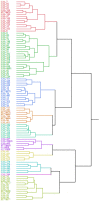Bio-fortification potential of global wild annual lentil core collection
- PMID: 29346404
- PMCID: PMC5773171
- DOI: 10.1371/journal.pone.0191122
Bio-fortification potential of global wild annual lentil core collection
Abstract
Lentil, generally known as poor man's' meat due to its high protein value is also a good source of dietary fiber, antioxidants and vitamins along with fast cooking characteristics. It could be used globally as a staple food crop to eradicate hidden hunger, if this nutritionally rich crop is further enriched with essential minerals. This requires identification of essential mineral rich germplasm. So, in the present study, a core set of 96 wild accessions extracted from 405 global wild annual collections comprising different species was analyzed to determine its bio-fortification potential. Impressive variation (mg/100 g) was observed for different minerals including Na (30-318), K (138.29-1578), P (37.50-593.75), Ca (4.74-188.75), Mg (15-159), Fe (2.82-14.12), Zn (1.29-12.62), Cu (0.5-7.12), Mn (1.22-9.99), Mo (1.02-11.89), Ni (0.16-3.49), Pb (0.01-0.58), Cd (0-0.03), Co (0-0.63) and As (0-0.02). Hierarchical clustering revealed high intra- and inter-specific variability. Further, correlation study showed positive significant association among minerals and between minerals including agro-morphological traits. Accessions representation from Turkey and Syria had maximum variability for different minerals. Diversity analysis exhibited wide geographical variations across gene-pool in core set. Potential use of the identified trait-specific genetic resources could be initial genetic material, for genetic base broadening and biofortification of cultivated lentil.
Conflict of interest statement
Figures
Similar articles
-
Diversity of macro- and micronutrients in the seeds of lentil landraces.ScientificWorldJournal. 2012;2012:710412. doi: 10.1100/2012/710412. Epub 2012 Sep 10. ScientificWorldJournal. 2012. PMID: 22997502 Free PMC article.
-
Evaluation and identification of wild lentil accessions for enhancing genetic gains of cultivated varieties.PLoS One. 2020 Mar 3;15(3):e0229554. doi: 10.1371/journal.pone.0229554. eCollection 2020. PLoS One. 2020. PMID: 32126106 Free PMC article.
-
Current Knowledge on Genetic Biofortification in Lentil.J Agric Food Chem. 2016 Aug 24;64(33):6383-96. doi: 10.1021/acs.jafc.6b02171. Epub 2016 Aug 15. J Agric Food Chem. 2016. PMID: 27507630 Review.
-
Global wild annual Lens collection: a potential resource for lentil genetic base broadening and yield enhancement.PLoS One. 2014 Sep 25;9(9):e107781. doi: 10.1371/journal.pone.0107781. eCollection 2014. PLoS One. 2014. PMID: 25254552 Free PMC article.
-
Lentil and Kale: Complementary Nutrient-Rich Whole Food Sources to Combat Micronutrient and Calorie Malnutrition.Nutrients. 2015 Nov 11;7(11):9285-98. doi: 10.3390/nu7115471. Nutrients. 2015. PMID: 26569296 Free PMC article. Review.
Cited by
-
Comparative Inter- and IntraSpecies Transcriptomics Revealed Key Differential Pathways Associated With Aluminium Stress Tolerance in Lentil.Front Plant Sci. 2021 Aug 31;12:693630. doi: 10.3389/fpls.2021.693630. eCollection 2021. Front Plant Sci. 2021. PMID: 34531881 Free PMC article.
-
Climate and landscape mediate patterns of low lentil productivity in Nepal.PLoS One. 2020 Apr 16;15(4):e0231377. doi: 10.1371/journal.pone.0231377. eCollection 2020. PLoS One. 2020. PMID: 32298316 Free PMC article.
-
Drought stress in Lens culinaris: effects, tolerance mechanism, and its smart reprogramming by using modern biotechnological approaches.Physiol Mol Biol Plants. 2024 Feb;30(2):227-247. doi: 10.1007/s12298-024-01417-w. Epub 2024 Feb 27. Physiol Mol Biol Plants. 2024. PMID: 38623164 Free PMC article. Review.
-
Heat and Drought Stress Impact on Phenology, Grain Yield, and Nutritional Quality of Lentil (Lens culinaris Medikus).Front Nutr. 2020 Nov 23;7:596307. doi: 10.3389/fnut.2020.596307. eCollection 2020. Front Nutr. 2020. PMID: 33330596 Free PMC article.
-
The Prospects of gene introgression from crop wild relatives into cultivated lentil for climate change mitigation.Front Plant Sci. 2023 Mar 10;14:1127239. doi: 10.3389/fpls.2023.1127239. eCollection 2023. Front Plant Sci. 2023. PMID: 36998696 Free PMC article. Review.
References
-
- White PJ, Broadly MR. Biofortification of crops with seven mineral elements often lacking in human diets—Iron, zinc, copper, calcium, magnesium, selenium and iodine. New Phytol. 2009;182:49–84. doi: 10.1111/j.1469-8137.2008.02738.x - DOI - PubMed
-
- Yang XE, Chen WR, Feng Y. Improving human micronutrient nutrition through biofortification in the soil plant system: China as a case study. Environ Geochem Health. 2007; 29(5): 413–428. doi: 10.1007/s10653-007-9086-0 - DOI - PubMed
-
- Hotz C, Brown KH. Assessment of the risk of zinc deficiency in populations and options for its control. Food Nutr Bull. 2004; 25(1) Suppl 2: S94–S204. - PubMed
-
- Cundeva K, Pavlovovska G, Stafilov T. Fe (III) heptthyldithiocarbamate as a new collector for floatation separation and preconcentration of Cr, Cu, and Pb, from fresh waters before their determination by ETAAS. J BrazChem Soc. 2007; 18: 1207–1214.
-
- Kaplan JH. Biochemistry of Na, K-ATPase. Ann Rev Biochem. 2002; 71: 511–535. doi: 10.1146/annurev.biochem.71.102201.141218 - DOI - PubMed
Publication types
MeSH terms
Substances
LinkOut - more resources
Full Text Sources
Other Literature Sources
Research Materials



